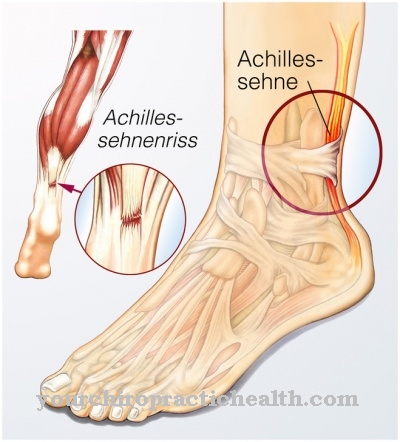In the Volkmann contracture it is an ischemic contracture that affects the flexor muscles in the forearm. Soft tissue shortening occurs as part of the disease, especially in the muscles. Volkmann's contractures are often the result of insufficient blood flow and damage to the nerves.
What is a Volkmann contracture?
In the Volkmann contracture nerve damage occurs as a result of so-called supracondylar fractures, for example in childhood. Often, constricting plasters, edema, extensive hematomas or foreign material are the triggers for the contracture.
The disease is characterized by a flexion deformity or claw hand. The Volkmann contracture occurs due to the insufficient supply of muscle groups on the arm with blood. As a result of the insufficient supply of blood, the corresponding muscle tissue dies. This shortens it and the Volkmann contracture can form.
causes
The Volkmann contracture can arise as a result of various triggers. As a rule, damage to the arteries and nerves of the affected forearm leads to neurological and muscular failure symptoms. Thus, the disease is caused by ischemia or nerve compression.
Even after humerus fractures located above the joint head, individual fragments can damage the ulnar nerve, the median nerve and the brachial artery due to compression. The development of a Volkmann contracture is favored by certain factors.
These include, for example, a cast that is too tight and unsplit, late treatment with irreversible damage to the soft tissues or inadequate reduction after fractures, which can lead to direct vascular injuries. The insufficient supply leads to necrosis and atrophy of the muscles in the forearm.
Symptoms, ailments & signs
Volkmann's contracture is usually associated with a number of symptoms and ailments that appear one after the other. The contracture is usually noticeable at the beginning of an acute onset of pain. Pressure-sensitive, hard tissue is then formed. The first signs of reduced blood flow appear. Finally, the affected patient experiences restricted mobility, which can become worse.
In the early stages of Volkmann's contracture, pain occurs in the area of the forearm, which can be associated with numbness and coldness in the fingers. In addition, there is a weakening of the pulse, which in most cases occurs together with a blue discoloration of the skin (cyanosis).
As the disease progresses, the muscles of the forearm and hand become atrophy. This leads to flexion and pronation contractures in the hand. The base joints of the fingers are hyperextended and the middle and end joints have a claw position (flexion). The thumb of the affected hand is fixed in an extended position. As part of the Volkmann contracture, the electrical excitability of diseased muscles disappears.
Diagnosis & course of disease
There are various methods of examination for diagnosing Volkmann's contracture. At the first signs of the disease, a specialist should be consulted immediately, who will discuss the symptoms and medical history with the patient concerned. Clinical and radiological methods of diagnosis are then available.
First, the attending physician checks the presence of characteristic symptoms of a Volkmann contracture. For example, the patient must indicate whether the sensitivity in the affected area is reduced. Symptoms such as the claw position of the finger joints are obvious and lead to the confirmation of the diagnosis.
Ultimately, the diagnosis of Volkmann's contracture can be confirmed by means of X-ray examinations if a bone fracture was present and the affected arm is in a cast. X-rays may indicate a potential inadequate reduction of the fracture, suggesting a Volkmann contracture.
Complications
First and foremost, the Volkmann contracture leads to severe pain. These can occur in the form of resting pain or stress pain, so that those affected are significantly restricted in their everyday life. Pain at rest can lead to sleep problems, especially at night, and thus to psychological upset or irritability of the person concerned.
The pain also spreads to the shoulders or neck. Due to the reduced blood flow, the Volkmann contracture also leads to paralysis or various sensory disorders, so that the patient suffers from severe movement restrictions in his everyday life. The pulse can also be weakened by the Volkmann contracture, so that the skin turns blue due to the reduced oxygen supply.
Furthermore, the muscles are weakened if the disease is not treated. The treatment of Volkmann's contracture always depends on the exact cause and the injury. As a rule, there are no complications if the disease is recognized and treated early.
In the worst case, the muscle tissue can die if left untreated and cannot be restored. The Volkmann contracture, however, does not have a negative effect on the life expectancy of the patient and does not reduce it. Even after a successful treatment, patients are dependent on various therapies.
When should you go to the doctor?
Since Volkmann's contracture usually cannot heal itself, the person affected is dependent on an examination and treatment by a doctor in any case. This is the only way to prevent or limit further complications and complaints. The earlier a doctor is consulted, the better the further course is usually.
A doctor should be consulted in the case of Volkmann's contracture if the person concerned suffers from severe restrictions in movement. As a rule, there is also very severe pain, which can severely limit the quality of life and everyday life of the person affected. Sensory disturbances or paralysis in the forearms can also indicate the Volkmann contracture and should be examined by a doctor if they occur over a longer period of time and do not go away on their own. A blue coloration of the affected region often also indicates this disease.
First and foremost, a general practitioner or an orthopedic surgeon can be seen. The further treatment then depends on the severity of the symptoms. A hospital can also be visited in an emergency or if the pain is very severe.
Therapy & Treatment
With regard to the therapy of Volkmann's contracture, various treatment-technical methods are available, which the attending physician weighs up depending on the severity of the disease, the exact location and the symptoms shown individually. If the affected arm is in a cast, the restrictive bandages must be removed immediately. In connection with this, it may be necessary in the course of a surgical procedure to split the fascia in the affected areas.
If the cause of the Volkmann contracture is an injury, this injury must first be treated. In some cases, it may be necessary to restore damaged blood vessels. If a bruise occurs inside a tendon sheath, it must be opened in the course of a surgical procedure. The bruise must be rinsed out.
Adequate follow-up treatments must be provided after the operations. For this purpose, intensive physical therapy exercises are usually necessary in order to regain optimal function of the muscles. If a particularly large amount of muscle tissue has died as a result of the Volkmann contracture and is consequently permanently shortened, this can lead to permanent movement restrictions.
In principle, after a Volkmann contracture, it is already too late for causal therapy. The impairment of the quality of life of the affected patient can be reduced by physiotherapy. Surgical application of so-called arthrodesis in the area of the elbow allows those affected to be treated symptomatically.
prevention
Preventive measures in relation to a Volkmann contracture exist and are primarily aimed at adequate treatment of fractures in the area of the forearm.
Supracondylar humeral fractures should be reduced as quickly and gently as possible. When applying plaster casts, care should be taken to split them. This means that the development of Volkmann contractures can be sensibly and effectively prevented and permanent damage can be avoided.
Aftercare
In the case of Volkmann's contracture, the scope of aftercare is basically based on the therapeutic measures initiated by the specialist. For the treatment of the disease, the treating specialist can specify surgery or self-healing. If the lower leg or forearm is affected, the specialist initiates the operation.
In the event of an operation, follow-up care focuses on closing the surgical wound and mobilizing the affected muscles. This is because it is generally not possible to close the wound with a suture during surgery. Alternatively, the wound is closed with a special wound covering (temporary skin replacement or vacuum sealing).
Sutures are closed about a week after the operation. In order to mobilize the affected muscles, intensive physiotherapy exercises and physiotherapeutic treatments (e.g. electrical stimulation) are usually provided. In individual cases, however, the movement of the fingers or the hand (e.g. making a fist) can remain restricted. In addition, the performance of the affected muscles does not fully regenerate during aftercare.
On average, a reduction in performance of 6 to 19 percent can be expected. Non-surgical therapy can be specified in the case of a Volkmann contracture caused by bruising in the thigh. The disease can heal on its own within a year. In this case, in addition to mobilizing the affected muscles, the affected person must be closely monitored clinically, neurologically and in a laboratory.
You can do that yourself
If a Volkmann contracture is suspected, the constricting plaster casts must be removed. Surgical splitting of the fascia may be necessary. The tendon and muscle damage caused can be treated with physiotherapy. Regular training of the affected muscles applies. The appropriate measures are based on the severity and location of the contracture. A sports doctor or physiotherapist can name training methods that those affected can carry out independently at home.
Positioning splints usually have to be worn at night in order to avoid further strain on the muscles. Since the forearm muscles, which enable the hand to flex, are severely weakened, no vehicle may be driven after a Volkmann contracture. Physical work is only possible with restrictions. The early search for alternative employment makes it easier to return to work.
In the late stages of the disease, the damaged muscle areas can no longer be healed. The self-help measures are limited to relieving pain by means of cooling, massages and wearing splints and not putting too much strain on the affected arm. Due to the ongoing physical limitations, a therapeutic approach to the triggering event and its consequences is advisable.


.jpg)










.jpg)

.jpg)
.jpg)











.jpg)